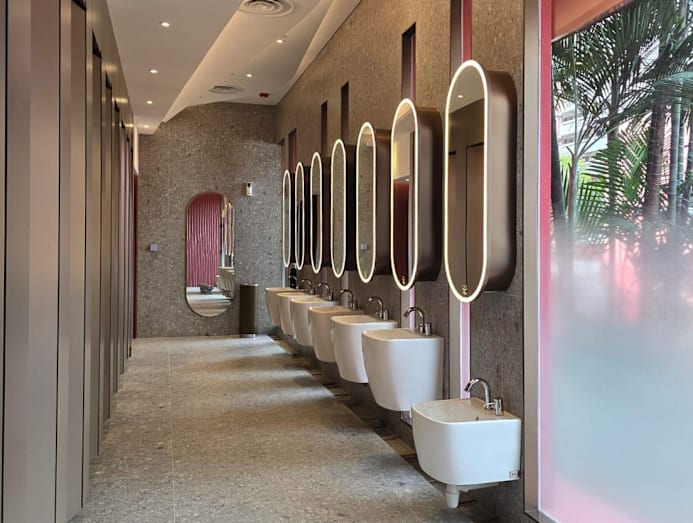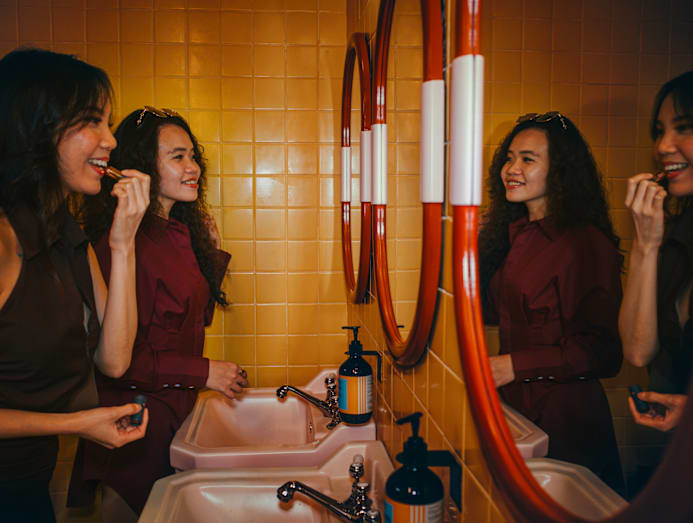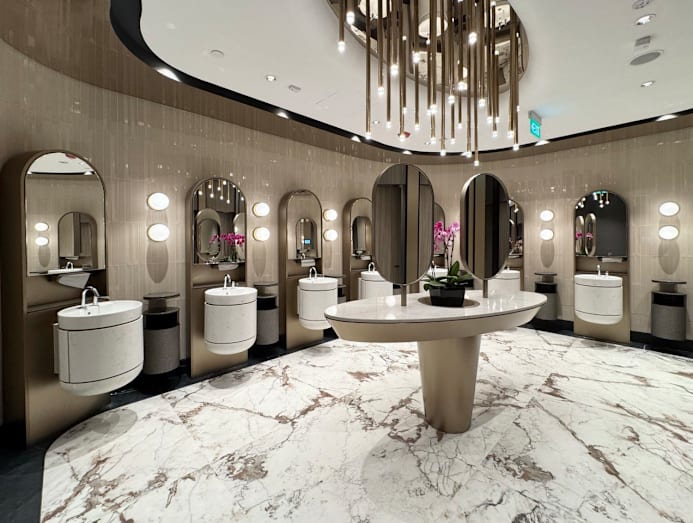Stuck in line: Why women spend more time in the loo – and why the queue is always so long
To commemorate World Toilet Day on Nov 19, 2025, CNA Women asks experts to explain how poor design – from outdated layouts to unequal toilet ratios – and a lack of understanding of women’s usage habits keep us waiting in line to use the public restroom.

The long queues at women’s toilets are a result of several factors, from the way women utilise restrooms to the time they spend inside the stall. (Art: CNA/Jasper Loh)

This audio is generated by an AI tool.
We’ve all been there, shifting from foot to foot in a restroom queue that seems to move at a glacial pace, while men stride in and out of theirs like it’s an express lane.
Ask any woman why it always takes so long and you’ll probably get a shrug and a bemused reply along the lines of “that’s just how it is”.
But the reason for the never-ending queue – and the longer time women spend in the restroom – is simple: Women’s and men’s toilets are unequal by design.
In the female restroom, stalls take up more space than urinals and include additional amenities such as sanitary bins and baby seats. Yet, women’s restrooms are often allocated the same amount of space as men’s toilets – a move that sounds fair in theory but ends up doing the opposite in practice.
Jack Sim, the founder of the World Toilet Organization, told CNA Women that it wasn’t until the 2000s that the idea of ‘potty parity’, which began in the West in the 1980s, started to take hold in Asia.
The movement arose to tackle the problem of women facing longer waiting times in public toilets, often due to old building codes that mandated that there had to be an equal number of fixtures for each gender, but didn’t take into account that women spend a longer time in the restroom compared with men.

It wasn’t until 2013 that Singapore’s National Environment Agency (NEA) updated its Code of Practice on Environmental Health. From June 2014, new buildings had to raise the ratio of female to male toilets from 1:1 to 5:3.
But since the update applied only to new buildings, older ones were stuck with outdated designs such as squat toilets – a feature carried over from early Housing Development Board flats that many women avoid today, adding to the wait.
SACRIFICING TOILET SPACE FOR REVENUE
You would think that newer malls and offices built after the guidelines were revised would have tackled this problem. Yet long queues continue to form outside some women’s restrooms.
This is where developer considerations come into play, said Jacqueline Pong, director of DP Architects, the firm behind SingPost Centre, Paya Lebar Quarter, Our Tampines Hub and The Woodleigh Mall.
“While toilets contribute to the gross floor area, they do not count under the net lettable area. Thus, developers may take into consideration revenue potential in their spatial allocation,” Pong explained.
Simply put, because toilets take up space but don’t directly generate income, some developers view them as cost centres and are less inclined to allocate room for them.
Sim, who, in 2005, helped bring China on board the potty parity movement by appealing to its desire to polish its public image ahead of the 2008 Beijing Olympics, added that this is also why you’d be hard-pressed to find a ground-floor restroom in most shopping malls in central Hong Kong – where real estate is priced at a premium.

Fortunately, most developers in Singapore recognise that cutting back on restroom space is a penny-wise, pound-foolish move. “Many developers have started to see them as part of the shopping experience. When shoppers are comfortable, they stay longer and spend more,” he said.
CLEANER, SMARTER, FASTER
Even when developers allocate more space for women’s restrooms, queues often remain – largely because user behaviour differs across genders, and design has yet to catch up.
Consider a woman’s trip to the restroom. After closing the stall door, she hangs up her bag and undresses (and heaven forbid she’s wearing a jumpsuit that day). She takes a few extra moments to make sure everything is clean, since her body and clothing may come into contact with more surfaces.
Once she’s done, the process runs in reverse: She wipes, flushes, adjusts her clothing, and gathers her belongings before stepping out.
It’s a far cry from the quicker routine in the men’s toilets, and all those extra steps add up. Sim estimated that while a man spends about 30 seconds at the urinal, a woman takes roughly twice as long in the stall.
Even more time is needed if it’s that time of the month, or if she’s accompanied by an elderly parent or young child.
“The longer time spent in toilets may also be due to caregiving duties, especially if mothers or guardians bring infants that require safe and secure fastening to infant seats before they can use the toilet,” said Pong.

After leaving the toilet stall, a woman’s hygiene and grooming habits – which tend to be more thorough than a man’s – also prolong her stay. The minutes can quickly pile up in restrooms that include dedicated vanity areas where women can touch-up their hair and makeup.
“Lounge-like areas or generous spatial proportions shift the toilet environment from utilitarian to welcoming, encouraging users to linger,” explained Pong.
This is exacerbated by the fact that women often go to the restroom in groups – a social habit that few men relate to.
“Culturally, men don’t like to talk in the toilet because it tends to stink of urine, so they try to quickly finish up and get out,” Sim added.
Finally, there’s the question of how layout influences circulation and, in turn, waiting times. Sim noted that placing dryers or paper-towel bins near entrances, for instance, can create a bottleneck. Pong added that inadequate space for queues – which usually form at the head of the row so users can enter the first available cubicle – often leads to lines spilling out of the restroom itself.
Ironically, congestion is sometimes made worse by the very design of public toilets. “To safeguard privacy, offset or maze-type entries are often used to block direct sightlines while allowing for doorless access to reduce contact,” Pong explained.
Not being able to see inside, however, means people outside may assume the line is short and join it when they could have gone to another restroom, leading to uneven crowding.
WHAT WOULD IT TAKE TO SHORTEN QUEUES?
Anyone who has stood in line for the women’s restroom while watching men breeze in and out of theirs has probably wondered: Would it be faster if toilets were gender-neutral?
The idea may be gaining traction in northern Europe, backed by studies showing it can ease queues, but Sim isn’t convinced it would fly in Singapore.
Beyond the practical challenge of converting toilet stalls into full-height cubicles, the public’s mixed response to Suntec Convention & Exhibition Centre’s temporary gender-neutral toilets in 2023 suggests we’re not quite there yet. Some welcomed it as a move towards inclusivity for the LGBT community, others dismissed it as a “woke” move and questioned its safety.


For now, perhaps the most practical fix is to make sure that cubicles are fully utilised – and that starts with keeping them clean.
“Co-location with the janitor’s room enables effective stocking and cleaning. The selection of durable and easy-to-maintain materials, together with wall-hung fixtures or partitions without floor supports, also facilitates ease of cleaning,” Pong said.
Facilities management teams are also benefiting from smart systems. At Downtown East, restrooms are equipped with ammonia sensors and people counters to monitor hygiene levels and trigger cleaning when needed – ensuring that toilet stalls remain functional and optimised for turnover.
Cleanliness aside, technology is also improving the user experience. Some shopping malls have started installing smart occupancy indicators that show which stalls are available before you even enter, much like the “occupied” lights on airplane lavatories.
“These are especially useful for larger toilets with many stalls or layouts with ‘left’ and ‘right’ banks. They serve as helpful guides to direct users to the less-occupied side,” Pong said.
Raffles City, for instance, incorporated these features in its recent overhaul of restrooms and nursing rooms. While they were at it, the designers also streamlined the restroom layout and added bespoke sink-and-mirror setups that provide users with more personal space and surfaces for their belongings.
“The feeling of being in the bathroom is very nice, as it should be. The toilet is a place you enter uneasy but leave refreshed. If done right, it can be the happiest room in the building,” said Pong.
CNA Women is a section on CNA Lifestyle that seeks to inform, empower and inspire the modern woman. If you have women-related news, issues and ideas to share with us, email CNAWomen [at] mediacorp.com.sg.






